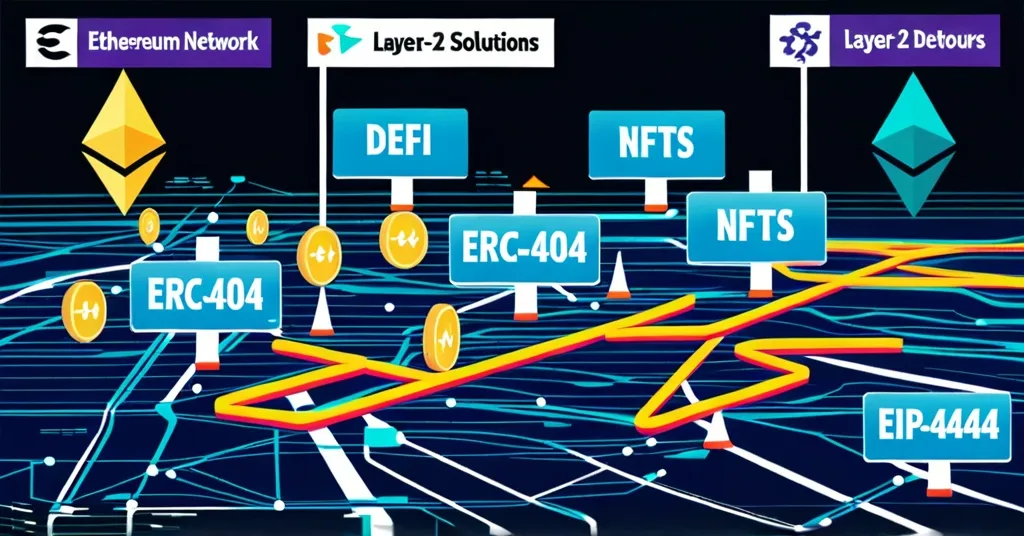Ethereum Gas Fees Hit 70 Gwei in 2024: DeFi, ERC-404, and NFTs Drive Surge

Ethereum Gas Fees in 2024: Navigating the Surge and Seeking Solutions
In early 2024, Ethereum gas fees surged to unprecedented levels, peaking at an average of 70 gwei on February 9, with some transactions reaching a staggering 377 gwei. This significant increase, driven by various factors including the growth of DeFi, the popularity of the ERC-404 token standard, and a resurgence in the NFT market, has prompted the community to seek innovative solutions like Layer-2 technologies and Ethereum Improvement Proposals (EIPs).
- Ethereum gas fees peaked at an average of 70 gwei on February 9, 2024
- Surge driven by DeFi growth, ERC-404 tokens, and NFT market resurgence
- Layer-2 solutions offer transactions as low as $0.01
- EIP-4844 aims to enhance scalability
On February 9, 2024, Ethereum gas fees reached a peak, averaging 70 gwei (a unit of Ethereum’s currency used to measure gas fees), with some transactions hitting an eye-watering 377 gwei. This surge isn’t just a hiccup; it’s a full-blown network congestion issue fueled by an array of factors. The rise of Decentralized Finance (DeFi) applications has been a significant contributor. DeFi platforms like Uniswap, Aave, and Curve, which rely on complex smart contracts, have been driving up gas fees as users flock to these services for trading, lending, and borrowing.
But DeFi alone isn’t to blame. Enter the ERC-404 token standard, a new kid on the block that’s been turning heads and wallets. ERC-404 tokens have sparked a speculative frenzy, with traders and investors eager to get in on the action, further straining the Ethereum network. And let’s not forget the NFT market, which has seen a surprising resurgence. The race to mint and trade these unique digital assets has led to what some might call ‘gas wars,’ where users bid up fees to ensure their transactions get processed first.
High gas fees pose real challenges for Ethereum’s ecosystem. For users, it means shelling out more ETH for basic transactions, which can deter participation, especially for those with smaller holdings. Developers, on the other hand, are under pressure to optimize their smart contracts and consider alternatives to keep costs down for their users.
This is where Layer-2 solutions come into play. Platforms like Arbitrum and Optimism have been lifesavers, offering a way to process transactions off the main Ethereum network, reducing congestion and slashing fees. Some users report transactions costing as little as $0.01 on these platforms, a stark contrast to the over $20 fees seen on the Ethereum mainnet during peak times. Layer-2 solutions are essentially secondary frameworks that handle transactions off-chain before settling them on the main Ethereum network, thus reducing the load and costs. For more insights on how these solutions work, check out discussions on Ethereum Layer-2 solutions.
But what about the future? Ethereum’s community isn’t sitting idly by. Ethereum Improvement Proposal EIP-4844, or Proto-Danksharding, has been implemented as part of the Cancun-Deneb upgrade in March 2024. This proposal introduces “blob transactions” to manage large data chunks more efficiently, aiming to lower transaction costs for Layer-2 rollups. While EIP-4844 is a step in the right direction, it’s not without its challenges, as it has introduced some network stability issues and increased fork rates. The introduction of a new “blob gas” fee market also adds a layer of complexity to Ethereum’s fee dynamics. To understand more about the impact of EIP-4844, visit Quora.
The impact of these high gas fees extends to applications like crypto casinos, which rely on quick and affordable transactions. These platforms are increasingly turning to Layer-2 solutions to maintain user experience and transaction speed, highlighting the broader implications for Ethereum’s ecosystem.
Despite the hurdles, the push for scalability and cost-efficiency continues. Experts view EIP-4844 as a crucial move toward solving Ethereum’s scalability trilemma, with the potential to reduce rollup transaction fees by up to 100x. This could open up new opportunities for DeFi platforms and NFT marketplaces, making Ethereum more accessible and competitive. To delve deeper into how Ethereum gas fees affect DeFi growth, read this analysis.
As we look ahead, the roadmap to full sharding, known as Danksharding, promises even greater scalability, with the potential to support hundreds of rollups and millions of transactions per second. This long-term vision underscores Ethereum’s commitment to becoming a leading platform for decentralized applications and financial services. For a comprehensive look at Ethereum’s scalability solutions in 2024, explore this resource.
On February 9, 2024, Ethereum gas fees peaked at an average of 70 gwei, with some transactions reaching a staggering 377 gwei—levels not seen since May 2023.
Layer-2 solutions have proven effective in reducing gas fees, with some platforms reporting transaction costs as low as $0.01.
Key Takeaways and Questions
- What causes the recent surge in Ethereum gas fees?
The surge is driven by increased network activity, the popularity of the ERC-404 token standard, growth in DeFi applications, and a resurgence in the NFT market.
- How do Layer-2 solutions help mitigate Ethereum’s gas fee problem?
Layer-2 solutions like Arbitrum and Optimism process transactions off-chain, reducing congestion and lowering fees, with some transactions costing as low as $0.01.
- What impact do high gas fees have on users and developers?
High gas fees can deter users from participating in Ethereum-based applications and put pressure on developers to optimize smart contracts and adopt Layer-2 solutions.
- Are there any proposed solutions to Ethereum’s scalability issues beyond Layer-2 technologies?
Yes, Ethereum Improvement Proposals like EIP-4844, which introduces proto-danksharding, are being considered to enhance Ethereum’s scalability.
- How do Ethereum’s scalability challenges affect applications like crypto casinos?
High gas fees can impact the accessibility of crypto casinos, prompting them to adopt Layer-2 solutions to improve user experience and transaction speed.
While Ethereum’s journey to greater scalability and affordability continues, the community remains committed to overcoming these challenges. Whether it’s through Layer-2 solutions or innovative EIPs, the future of Ethereum looks promising, albeit with a few bumps along the road. And hey, if you’re betting on Ethereum’s future, just make sure you’re not overpaying for those gas fees!
While Ethereum’s journey to greater scalability and affordability continues, the community remains committed to overcoming these challenges. Whether it’s through Layer-2 solutions or innovative EIPs, the future of Ethereum looks promising, albeit with a few bumps along the road. And hey, if you’re betting on Ethereum’s future, just make sure you’re not overpaying for those gas fees!
As Bitcoin maximalists, we recognize the importance of Ethereum’s role in the broader crypto ecosystem. Ethereum’s challenges with gas fees and scalability highlight the ongoing need for innovation and improvement in all blockchain networks. While Bitcoin remains the king of digital assets, Ethereum’s efforts to solve its issues could lead to broader adoption of decentralized technologies across various sectors, from DeFi to gaming. The interplay between Bitcoin’s stability and Ethereum’s flexibility is crucial for the evolution of the crypto space.
Yet, we must not lose sight of the broader picture. While Ethereum grapples with its issues, Bitcoin continues to serve as the bedrock of the cryptocurrency world, offering a proven store of value and a beacon of decentralization. The challenges Ethereum faces are a reminder of the importance of continuous innovation and the need for a balanced ecosystem where different cryptocurrencies and blockchains fulfill their unique niches.
So, as we watch Ethereum navigate its gas fee surge and scalability solutions, let’s remember the bigger mission at hand: fostering a decentralized, private, and disruptive financial revolution that challenges the status quo and accelerates technological progress. Whether it’s through Bitcoin’s steadfastness or Ethereum’s adaptability, every step forward in this space is a victory for the principles of e/acc and the future of finance.



